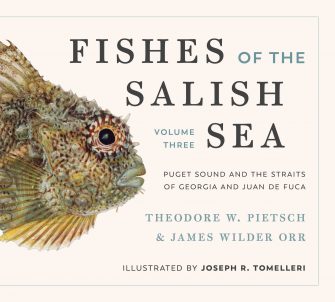#692 Fishes of the Salish Sea
Fishes of the Salish Sea (3 volumes)
by Theodore Wells Pietsch and James Wilder Orr, illustrated by Joseph R. Tomelleri
Victoria: Heritage House, 2019; Seattle: University of Washington Press, 2019
$179.00 / 9781772032932
Reviewed by Colin Levings
*
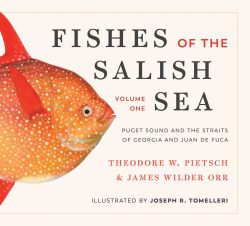 This book is an extraordinary addition to the natural history of the Salish Sea. Authors Theodore Wells (Ted) Pietsch and James Wilder (Jay) Orr, as well as illustrator Joseph R. Tomelleri, deserve strong compliments for their encyclopaedic work. Presented in three volumes, Fishes of the Salish Sea is a medley of history, science and artwork, with chapters somewhat aligning with these themes.
This book is an extraordinary addition to the natural history of the Salish Sea. Authors Theodore Wells (Ted) Pietsch and James Wilder (Jay) Orr, as well as illustrator Joseph R. Tomelleri, deserve strong compliments for their encyclopaedic work. Presented in three volumes, Fishes of the Salish Sea is a medley of history, science and artwork, with chapters somewhat aligning with these themes.
In Volume One (214 pages) the introductory chapter includes a good general description of geography, oceanography and geology of the Salish Sea, which includes the Strait of Georgia in British Columbia, Puget Sound, Washington, and the Strait of Juan de Fuca between Vancouver Island in Canada and the Olympic Peninsula in Washington State. The seaward boundary of Juan de Fuca is a little hard to define as there are no “edges” (other than boundaries that might be defined by ocean properties such as temperature and salinity) to define it — there is only the open Pacific at its western end. This has an effect on the distribution of numerous fish species, as I will mention later. On a smaller scale, the upriver boundary in the estuaries of the Salish Sea are also relevant.
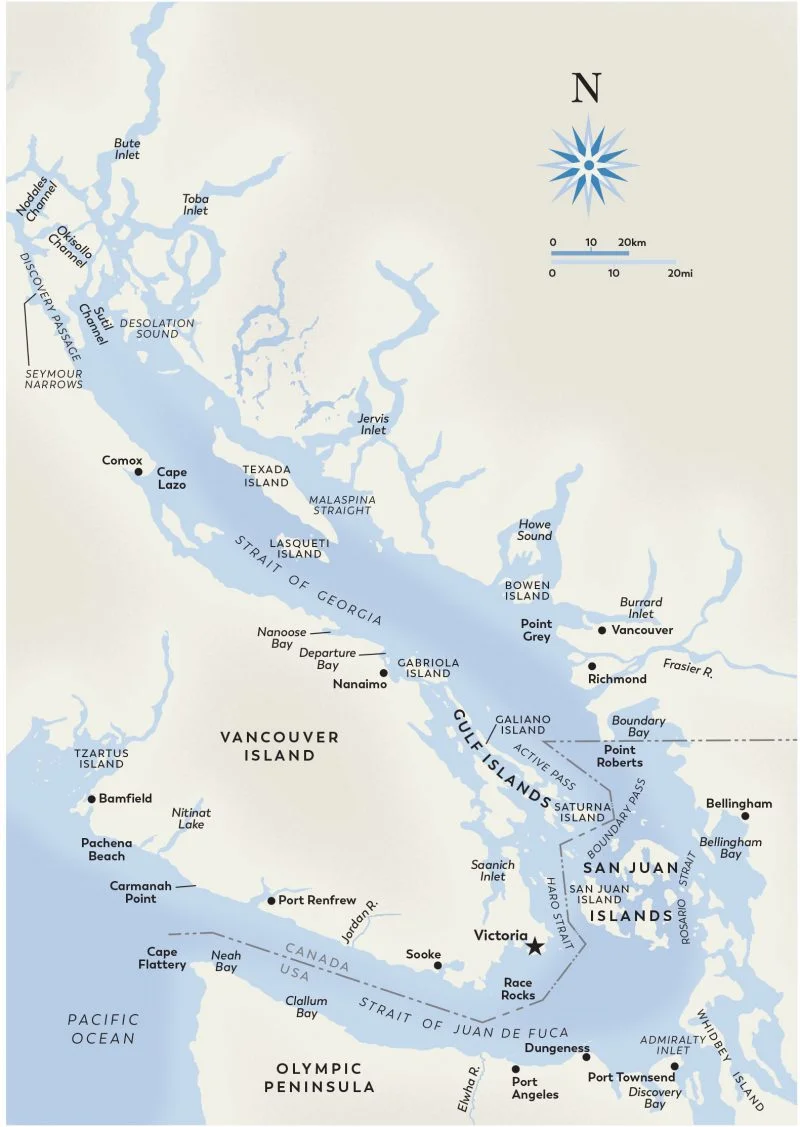

An outline or framework for the types of fishes and habitats covered then follows, including literature, collections and museums searched for fish records from the Salish Sea. The University of Washington fish museum, where the authors were based, was a key source. Important aspects of ichthyology (the study of fish) are mentioned, including details of how scientific names are assigned to fish, definitions related to taxonomy or fish classification, how distributions were assigned, and what aspects of biology of individual species the authors decided to include. The use of keys to identify a fish is then described. Keys — a series of choices based on the fish’s anatomy, colour, and other features — are designed, Pietsch and Orr write, to “lead the user to the correct name of a given item.” The authors do not to mention the use of DNA as a method of identifying a fish, realizing perhaps that most people do not have the tools of this modern technology, although it is becoming the technique of choice by professionals when faced with a difficult identification of a species. DNA is mentioned in the Glossary, however. The Introduction concludes with a discussion of how fish artist Joseph R. Tomelleri developed the wonderful colour illustrations of each of the 260 species covered in the book.
The chapter entitled Historical Perspective is a detailed and well-illustrated account of the explorers, naturalists, and scientists who have provided early knowledge of the fishes of the Salish Sea. Much of the basic information on fish fauna was gathered in the 19th century by British and American expeditions and surveys for coastal navigation and railway routes. There were extensive collecting trips mounted by United States agencies (including trips by the famous United States Fish Commission ship USS Albatross, and universities such as Columbia and Stanford. Some of the most famous US ichthyologists, including David Starr Jordan and Charles Henry Gilbert, were involved in these surveys.
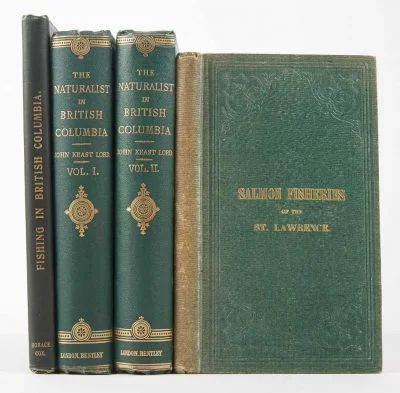
I found the account of British naturalist John Keast Lord’s work from HMS Plumper in the Strait of Georgia when participating in the 1860 British North American Boundary Commission particularly interesting as this expedition has a relatively low profile in the region. Curiously, it is known as the Sunshine Coast Survey although collections were made at numerous locations in the Strait.
In the 20th and 21st centuries, work in fishes in the Salish Sea increased significantly with studies at several loci in the region: University of Washington and the US National Oceanic and Atmospheric Administration’s Montlake Laboratory in Seattle, University of British Columbia in Vancouver, Pacific Biological Station in Nanaimo and the (now) Royal British Columbia Museum in Victoria. The history of these institutions is described, along with a few others, with an emphasis on their role in adding to our taxonomic knowledge of Salish Sea fishes. The authors also give a well-balanced narrative on the accomplishments of the biologists who worked or are working at these various institutions. There is a long history of cross-border collaboration among fish specialists. In the early days, presumably because of a shortage of specialists in Canada, American researchers often provided the original descriptions of fish first found in Canadian waters. An example found later on in the book in the species profile chapter is the spiny nose sculpin caught sometime before 1910 by George William Taylor at the Pacific Biological Station in Nanaimo, but later identified and named by Gilbert from Stanford University. As a result of the cross-border work, many original specimens of newly-named fish caught in the Canadian Salish Sea are in American museums.

In the next chapter, the authors describe the origins and present distribution of the community of fishes that have been found in the Salish Sea or, in the jargon of fish biologists, its ichthyofauna. A description of the geological processes that created the Salish Sea basin is given — fjords, deep basins, rocky shores, sand beaches, and estuaries provide a lot of ecological niches that developed as glaciers receded and the coastline was formed. This variety of habitats enabled fish species from the north and south coasts of the northeast Pacific to colonize the area. Because the Pleistocene ice receded only about 10,000 years ago, there has apparently been limited time to evolve fish species that are “endemic” — that is, found only in the Salish Sea. The Blackfin Fathead, a bullhead-like deepwater fish only found in a few places in Puget Sound and off Mayne Island in the Strait of Georgia, is a possible exception. The authors also provide an overview of the main habitat or distributional factors that can determine if a species that colonized the region from offshore can survive and have a viable reproducing population in the Salish Sea — for example temperature, salinity, and dissolved oxygen). Only a sentence is devoted to anthropogenic factors such as overfishing, pollution, and habitat degradation.
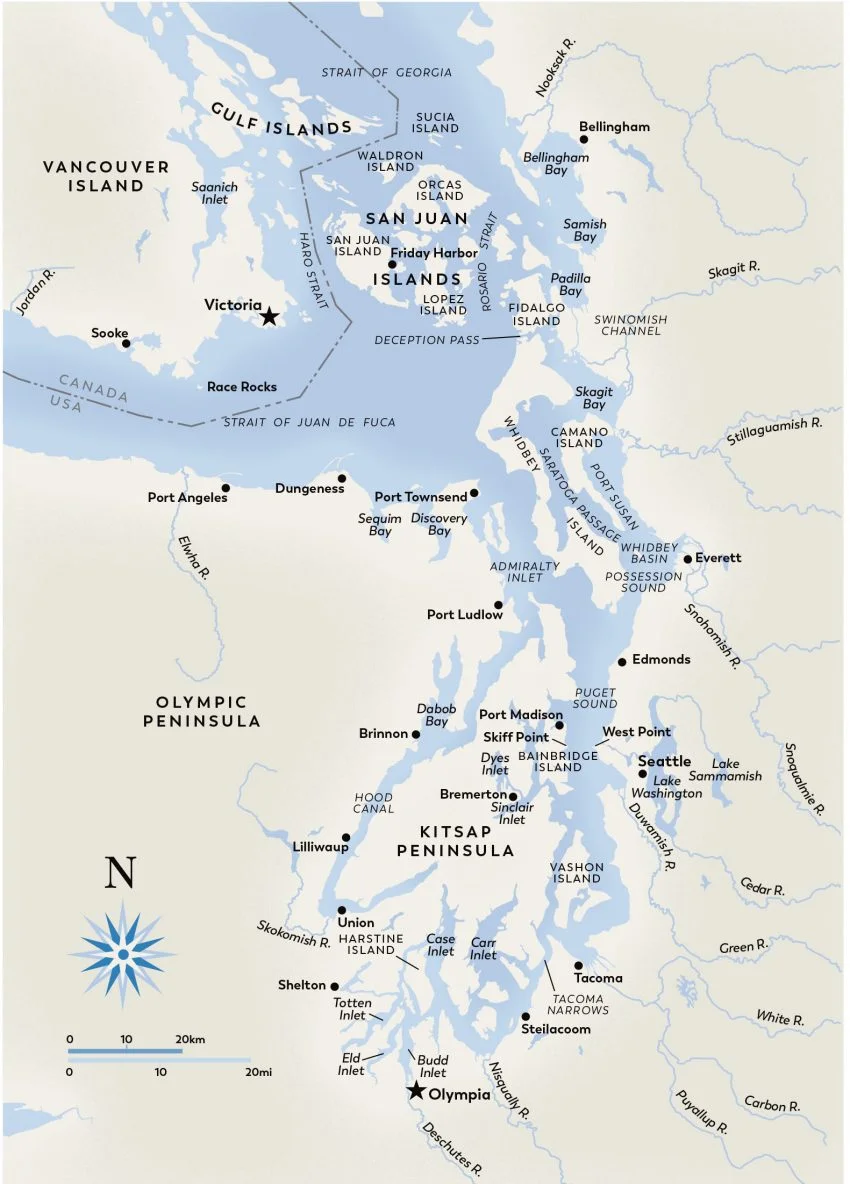

The authors also give discussion around the five fish (American Shad, Striped Bass, Common Carp, Atlantic Salmon, and Sheepshead Minnow) that have been accidentally or purposefully introduced to the Salish Sea or other areas of the northeast Pacific and subsequently have been found in the region. The American Shad, for example, has spread northwards into the region after it was introduced in California. Records for species like this, as well as many other “rare” species, are somewhat tricky to interpret because occasional records for fish that have been found only a few times do not necessarily indicate a reproducing population, which would be the worst-case scenario with respect to competition and other possible ecological effects on endemic species. As well, there may be more of these rare species out there that have not been found because of lack of sampling. More of these strays can be expected when warm water masses move up from the south, especially on Juan de Fuca Strait, which borders on the open Pacific. A recent example is the spotted porcupine fish found recently off Jordan River.
The Common Carp is an example of introduced species that does have a self-reproducing population in the Canadian Salish Sea, e.g. in the tidal sloughs of the Fraser River estuary. This chapter of Fishes of the Salish Sea would have been a nice place to remind readers not to dump their unwanted aquarium fish or other foreign aquatic species into the Salish Sea, especially in estuaries where freshwater species such as goldfish (which are very closely related to carp) have opportunities to colonize.
Table 1 in this chapter provides a summary of the where the 260 species have been recorded in eight areas within the Salish Sea: Juan de Fuca Strait, San Juan Islands, Boundary Bay, Southern Strait of Georgia, Northern Strait of Georgia, northern Puget Sound, Southern Puget Sound, and Hood Canal. Readers interested in more specific areas on both sides of the border can find records of fishes in the species profiles chapter.
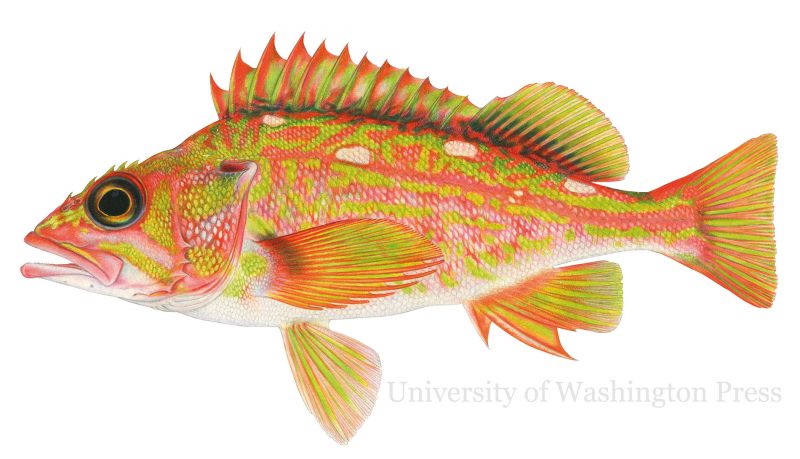
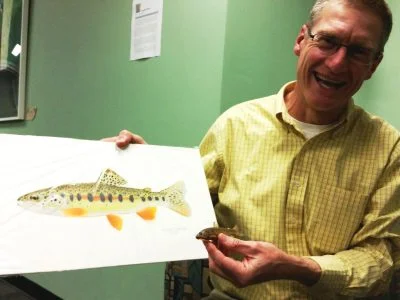
The next chapter in Volume 1 consists of pictorial keys to the families of Salish Sea fishes. The technical terms used in the dichotomous (or binary) keys are defined in a Glossary. The black and white outline drawings provide good images of the various families described. Following the keys, a chapter details the classification, to the species level, of the fish found in the region. The authors follow the classical terminology developed by Swedish biologist Linnaeus, modernized and adapted as required to current thinking by today’s ichthyologists.
The chapter entitled “Describers of Salish Sea Fishes” is a distinctive aspect of the book. The authors have delved in the life history of each of the ichthyologists who first formally described a species, or in most cases several species, found in the Salish Sea. Because many species are found outside of the region in areas of the world that were investigated before studies in the Salish Sea were initiated, they were first identified elsewhere. As well, many species were identified in museums in European countries as first explorers brought specimens back home for identification. People from thirteen countries contributed, with American, English, and French researchers in the top ranks. Only two Canadians have named fish species in the Salish Sea – UBC-based Norman Joseph Wilimovsky (1925-1997) and his student Donald Edward Wilson (1948-2017). However, a look at the persons named in the Historical Perspective chapter and author affiliations in the extensive reference list reveals that numerous Canadian ichthyologists have made extensive and pioneering studies on the ecology, genetics, physiology, and other aspects of fish biology in the region.
The penultimate chapter in this first volume of Fishes of the Salish Sea is an index of biographical names, particularly useful as the information keys into page numbers for the species first described by the various persons. An index of scientific and common fish names ends the volume. The indices of biographical names and scientific and common fish names at the end of this volume are repeated at end of the next two volumes.
*
Volumes Two (430 pages) and Three (298 pages) of Fishes of the Salish Sea provide species profiles for 80 families of fishes found in the Salish Sea, beginning with what are considered the most primitive groups, the hagfishes and lampreys, and continuing through the more advanced groups to the sunfish, considered to be an advanced form. Keys are provided for the more complex families. A good description of the characteristics of the particular family is first given. Each following species profile then includes the scientific and common name of the species, how generally to recognize it, a detailed description, size range, geographic distribution, habitat and life history, etymology of the name (the origin of the name and the historical development of its meaning), and key references. Each profile includes a splendid colour drawing by Tomelleri and a page reference to a larger plate at the end of the volume.
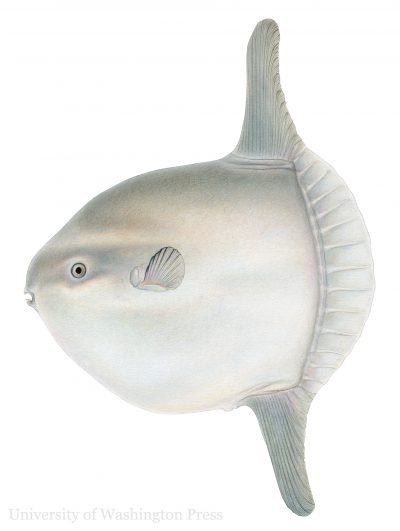
A thorough review of the vast amount of information in the species profiles, especially on the known ranges of particular species, is well beyond the scope of my review. However, I did note a very few corrections or omissions. There is an unfortunate typo or editing problem in Table 1 as the footnote “b,” to indicate an introduced species, is attached to 23 species in addition to the five introductions mentioned in the text. The authors state that Green Sturgeon is found in the upper Fraser River, but this is likely an error as only White Sturgeon has been found there. It would have been interesting to have some mention of the First Nations’ names for the various species and there is a wealth of Indigenous traditional knowledge available that could be tapped for future writings on Salish Sea fishes. Finally, the species profiles mention a lot of specific locations where various species have been found; but without the very detailed maps required, the reader is somewhat lost on the geography involved unless one has Google maps or similar at the ready.
In summary, there is no doubt that Fishes of the Salish Seat is a current “go to” book for people interested in fish of this west coast region and an excellent supplement to existing literature and the several fish guide books available. It should be of interest to the citizen scientist, especially those with a bent toward the history of fish science in the region. However, it does have serious logistic limitations for field identification, and considering the total weight of the books is about 6 kg, they are unlikely to be taken in a backpack to the beach or stored on a shelf in the cabin of a small boat. As well, although the amazing colour illustrations are a great help, there is a fair amount of anatomical terminology to work through to verify the identification of a species.
Nevertheless, for professionals, students, and serious armchair fish persons, Fishes of the Salish Sea is a valuable contribution to regional marine ecology and the perfect book to read on a winter’s day when the seasonal southeast gales keep most people, even divers, off the Salish Sea.
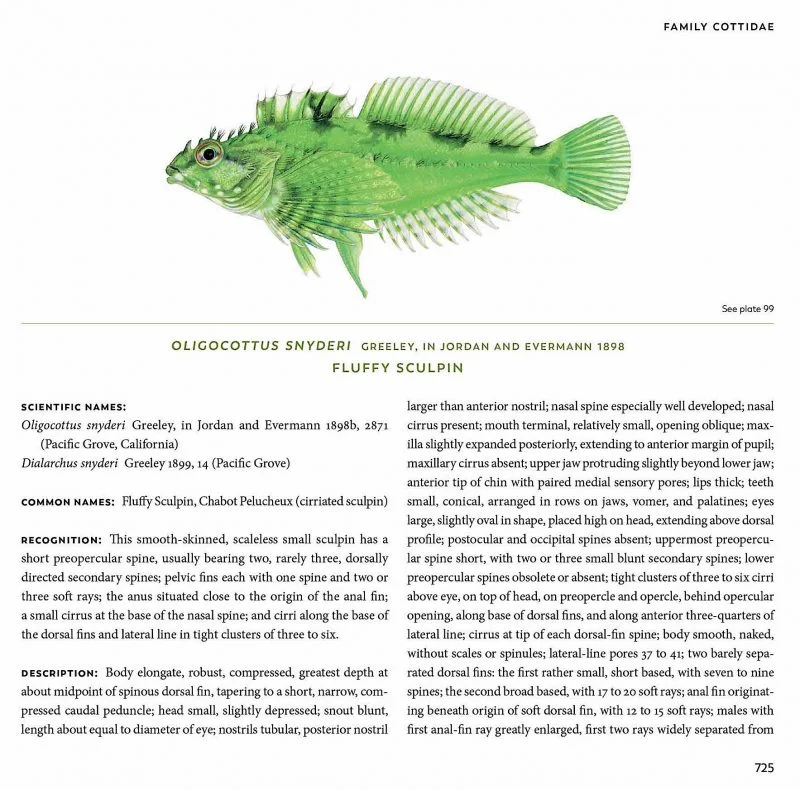
*

Colin Levings was born in 1942 in Victoria. He went to high school in North Surrey and as a youth spent a lot of time fishing in the lower Fraser River. Colin began his career in marine science in 1962 as sea-going technician in Alaska working for the International Pacific Halibut Commission. He earned his B.Sc. and M.Sc. at UBC and his Ph.D. at Dalhousie University in Halifax. Colin retired as a research scientist from Fisheries and Oceans Canada in 2006 but keeps working as a reviewer, advisor, writer, and mentor: see his website for lists of publications, presentations, and photo galleries. As well as conducting many estuary studies in British Columbia, Colin worked on marine fish ecology projects in the Strait of Georgia and elsewhere on the Coast. Recently he has been researching Edward Flanders Ricketts’ (author of Between Pacific Tides) studies in British Columbia. His recent book on salmonids in estuaries — Ecology of Salmonids in Estuaries Around the World: Adaptations, Habitats, and Conservation (UBC Press 2016) — was reviewed in The Ormsby Review no. 113 (April 4, 2017). Colin and his wife Kay live in Lions Bay and also spend time in Pender Harbour.
*
The Ormsby Review. More Books. More Reviews. More Often.
Publisher and Editor: Richard Mackie
The Ormsby Review is a journal service for serious coverage of B.C. books and authors, hosted by Simon Fraser University. The Advisory Board consists of Jean Barman, Robin Fisher, Cole Harris, Wade Davis, Hugh Johnston, Patricia Roy, David Stouck, and Graeme Wynn. Scholarly Patron: SFU Graduate Liberal Studies. Honorary Patron: Yosef Wosk. Provincial Government Patron since September 2018: Creative BC
“Only connect.” – E.M. Forster

